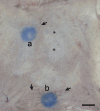Allergenic response induced by Pterobothrium crassicolle (Cestoda: Trypanorhyncha) extracts in murine model
- PMID: 39046076
- PMCID: PMC11340865
- DOI: 10.1590/S1984-29612024039
Allergenic response induced by Pterobothrium crassicolle (Cestoda: Trypanorhyncha) extracts in murine model
Abstract
The aim of this study was to determine the allergenic activity of components present in crude extracts of Pterobothrium crassicolle plerocerci (CPE) and blastocysts (CBE) obtained from Micropogonias furnieri in a murine model. Two groups of seven animals each received 50 µg of CPE or CBE on days 1, 35 and 120. Serum samples were tested by ELISA and Immunoblotting. Specific IgG and IgE levels were detected by ELISA, showing specific humoral responses for the primary immunization for both immunoglobulins and continuously growing titers for IgE. Positive Passive Cutaneous Anaphylaxis tests in rats sensitized with anti-CBE sera and tested by CBE, showed biologically, the allergenic activity of the extracts. The CPE and CBE showed some different recognition regions but both experimental groups recognized all regions of the extracts when tested for cross reactions, showing that CPE and CBE could share antigenic recognition sites.
O objetivo deste estudo foi determinar a atividade alergênica de componentes presentes em extratos crus de plerocercos (CPE) e de blastocistos de Pterobothrium crassicolle (CBE), obtidos de Micropogonias furnieri, em modelo murino. Dois grupos de sete animais receberam cada um 50 µg de CPE ou CBE nos dias 1, 35 e 120. As amostras de soro foram testadas por ELISA e Imunoblot. Os níveis específicos de IgG e IgE foram detectados por ELISA, mostrando respostas humorais específicas para a imunização primária para ambas as imunoglobulinas e títulos crescentes de IgE. Testes positivos de Anafilaxia Cutânea Passiva em ratos sensibilizados com soros anti-CBE e testados por CBE, demonstraram biologicamente, a atividade alergênica dos extratos. O CPE e o CBE evidenciaram algumas regiões de reconhecimento diferentes, mas ambos os grupos experimentais reconheceram todas as regiões dos extratos, quando testados para reações cruzadas, mostrando que o CPE e o CBE poderiam compartilhar locais de reconhecimento antigênico.
Conflict of interest statement
Figures



Similar articles
-
Immunogenic activity of the fish tapeworm Pterobothrium heteracanthum (Trypanorhyncha: Pterobothriidae) in BALB/c mice.J Helminthol. 2015 Mar;89(2):203-7. doi: 10.1017/S0022149X13000795. Epub 2013 Dec 3. J Helminthol. 2015. PMID: 24299909
-
Allergenic activity of Molicola horridus (Cestoda, Trypanorhyncha), a cosmopolitan fish parasite, in a mouse model.Vet Parasitol. 2008 Nov 7;157(3-4):314-20. doi: 10.1016/j.vetpar.2008.07.010. Epub 2008 Jul 23. Vet Parasitol. 2008. PMID: 18790571
-
Gobioides broussonnetii (Gobiidae): a new host for Pterobothrium crassicolle (Trypanorhyncha) on Marajó Island, northern Brazil.Rev Bras Parasitol Vet. 2013 Jul-Sep;22(3):398-401. doi: 10.1590/S1984-29612013000300013. Rev Bras Parasitol Vet. 2013. PMID: 24142172
-
Pterobothrium crassicolle parasitizing Paralichthys orbignyanus (Osteichthyes, Paralichthyidae) in Brazil.An Acad Bras Cienc. 2018 Apr-Jun;90(2):1605-1610. doi: 10.1590/0001-3765201820170323. Epub 2018 May 14. An Acad Bras Cienc. 2018. PMID: 29768571
-
Use of monoclonal antibodies for the characterization of allergenic extracts.Ann Ist Super Sanita. 1991;27(1):183-7. Ann Ist Super Sanita. 1991. PMID: 1720293 Review.
Cited by
-
Anti-Pterobothrium heteracanthum (Trypanorhyncha: Pterobothriidae) IgG in human serum samples.Rev Bras Parasitol Vet. 2024 Nov 22;33(4):e014724. doi: 10.1590/S1984-29612024071. eCollection 2024. Rev Bras Parasitol Vet. 2024. PMID: 39607275 Free PMC article.
References
-
- Al-Zubaidy AB, Mhaisen FT. Larval tapeworms (Cestoda: Trypanorhyncha) from some Red Sea fishes, Yemen. Mesop J Mar Sci. 2011;26(1):1–14. doi: 10.58629/mjms.v26i1.186. - DOI
-
- Antunes DMF, da Costa JP, Campos SMN, Paschoal PO, Garrido V, Siqueira M, et al. The serum D-xylose test as a useful tool to identify malabsorption in rats with antigen specific gut inflammatory reaction. Int J Exp Pathol. 2009;90(2):141–147. doi: 10.1111/j.1365-2613.2008.00627.x. - DOI - PMC - PubMed
-
- Beveridge I, Haseli M, Ivanov VA, Menoret A, Schaeffner BC. In: Planetary Biodiversity Inventory (2008–2017): Tapeworms from Vertebrate Bowels of the Earth. Caira JN, Jensen K, editors. Lawrence: The University of Kansas, Natural History Museum; 2017. Trypanorhyncha Diesing, 1863; pp. 401–429. (Special Publication).
MeSH terms
Substances
LinkOut - more resources
Full Text Sources
Research Materials
Miscellaneous

